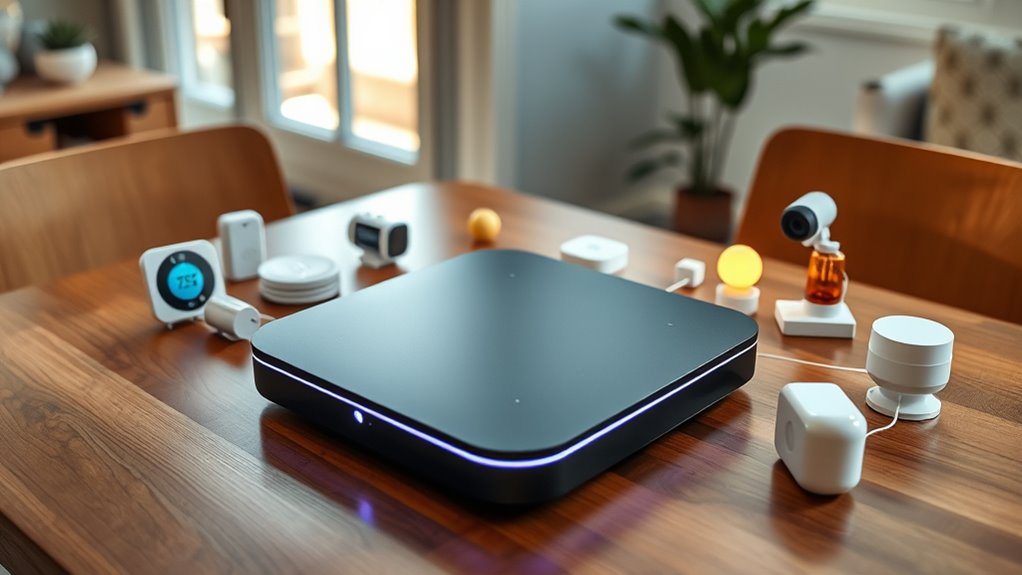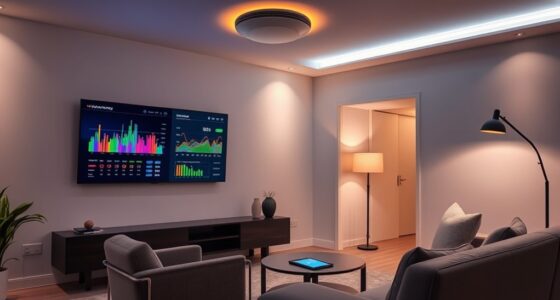Smart home hubs act as central control points that unify device management across different brands and protocols, making your household automation more efficient. They support universal protocols like Zigbee and Z-Wave, ensuring compatibility with a wide range of devices. By integrating with voice assistants like Alexa or Google Assistant, they simplify control and automation. This setup boosts flexibility, reliability, and ease of use, helping you streamline your smart home setup. Keep exploring to discover how these hubs can enhance your home management.
Key Takeaways
- Smart home hubs act as central control points, managing multiple connected devices from a single platform.
- Universal protocols like Zigbee and Z-Wave enable broad device compatibility and seamless communication.
- They support integration with voice assistants such as Alexa, Google Assistant, and Siri for hands-free control.
- Hubs simplify setup, automate routines, and coordinate devices across various brands and protocols.
- Using a versatile hub enhances system reliability, flexibility, and future-proofing of your smart home ecosystem.

Smart home hubs serve as the central control point for managing all your connected devices, making it easier to automate and monitor your household. With a hub in place, you don’t need to juggle multiple apps or interfaces to control your smart devices. Instead, you can access everything from a single platform, streamlining your daily routines. One of the key features of modern smart home hubs is voice control, which allows you to command your devices hands-free. Just speak your commands, and your hub will interpret and execute them, providing a seamless experience. Whether you want to turn on the lights, adjust the thermostat, or play music, voice control offers a natural, intuitive way to manage your home.
Device compatibility is equally important when choosing a smart home hub. Not all hubs work with every device, so you need one that supports your existing ecosystem. Many hubs now embrace universal protocols like Zigbee and Z-Wave, which enable broad compatibility across brands and device types. This means you can connect smart bulbs, locks, sensors, and other gadgets regardless of their manufacturer. By ensuring your hub supports multiple protocols, you prevent the frustration of incompatible devices and future-proof your smart home setup. You’ll also find that the most versatile hubs offer integration with popular voice assistants like Alexa, Google Assistant, or Siri, further expanding your control options.
When you pick a smart home hub that emphasizes device compatibility, you gain flexibility. You’re no longer limited to a single brand or ecosystem, which gives you more choices and customization options. Plus, a compatible hub simplifies setup and management—once connected, you can automate complex routines that involve multiple devices working together. These automations can be triggered by time, location, or voice commands, making your home smarter and more efficient. The hub acts as a translator and coordinator, ensuring that all devices respond correctly to your commands, regardless of their native communication protocol. Incorporating protocol compatibility can enhance the overall performance and reliability of your smart home system.
In essence, a smart home hub with strong voice control features and broad device compatibility transforms your living space into a connected, efficient environment. It reduces the complexity of managing multiple devices and enhances your control options. With the right hub, you’ll enjoy a more integrated home experience where automation feels natural and effortless. Whether you’re controlling lights, security systems, or entertainment, a centralized hub makes your smart home genuinely smarter.
Frequently Asked Questions
Can Smart Home Hubs Work With All Brands Simultaneously?
Yes, smart home hubs can work with all brands simultaneously, but it depends on their brand compatibility and device integration capabilities. You need to choose a hub that supports multiple protocols like Zigbee or Z-Wave, ensuring it can connect with various brands. When set up correctly, your hub will seamlessly control your diverse devices, giving you centralized control regardless of brand differences. Just make sure to verify compatibility before purchasing.
How Secure Are Smart Home Hubs From Hacking?
Smart home hubs have security measures, but you should stay aware of privacy concerns and hacking vulnerabilities. They can be targeted, so make certain you update firmware regularly, use strong passwords, and enable two-factor authentication when possible. While hubs improve convenience, they can also expose your devices if not properly secured. Taking these precautions helps protect your home network from potential hacking threats.
Do Hubs Require Professional Installation or Setup?
Setting up your smart home hub is like painting a canvas—you can do it yourself or hire a professional. Usually, the installation complexity is manageable, and user setup is straightforward with clear instructions. You don’t need specialized skills; most hubs guide you step-by-step. With patience, you’ll have your centralized control system running smoothly, making your smart home feel like a seamlessly choreographed dance—no professional needed unless you prefer expert finesse.
Are There Energy Consumption Concerns With Constantly Connected Hubs?
Yes, there are energy consumption concerns with constantly connected hubs. They use energy to stay online and communicate with your devices, which increases overall power consumption. While the energy usage is typically low, it can add up over time, especially if you have multiple hubs. To reduce power consumption, consider turning off the hub when not in use or opting for energy-efficient models.
How Often Do Hubs Need Firmware Updates?
You might think hubs need updates every day, but they actually only require firmware updates a few times a year. During these updates, security protocols are strengthened, making your smart home safer and more reliable. Skipping updates isn’t an option—they patch vulnerabilities and improve performance. So, stay on top of firmware updates, and your hub will keep your connected devices secure and running smoothly, without any unnecessary hassle.
Conclusion
A smart home hub simplifies your life, bringing all your devices together seamlessly. It’s the command center that makes automation effortless and control intuitive. Yet, despite its power and convenience, it’s only as good as the protocols it supports. You gain unity and chaos, order and complexity, all in one device. Embrace the hub, and you’ll find harmony in your smart home—where technology and everyday living come together effortlessly.









